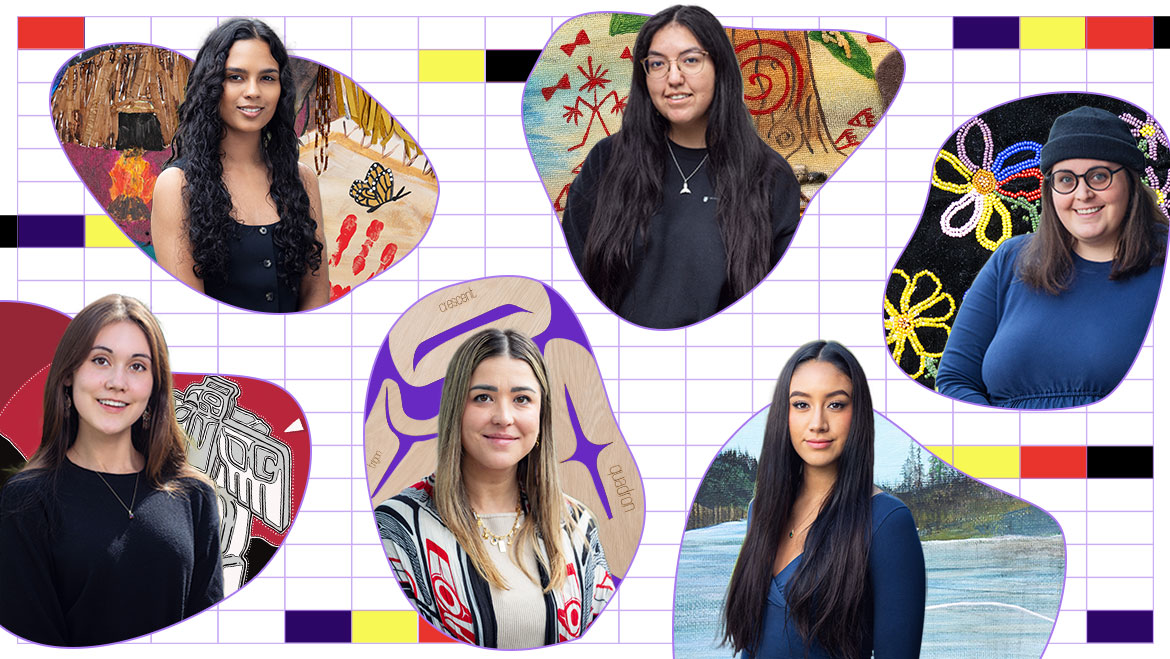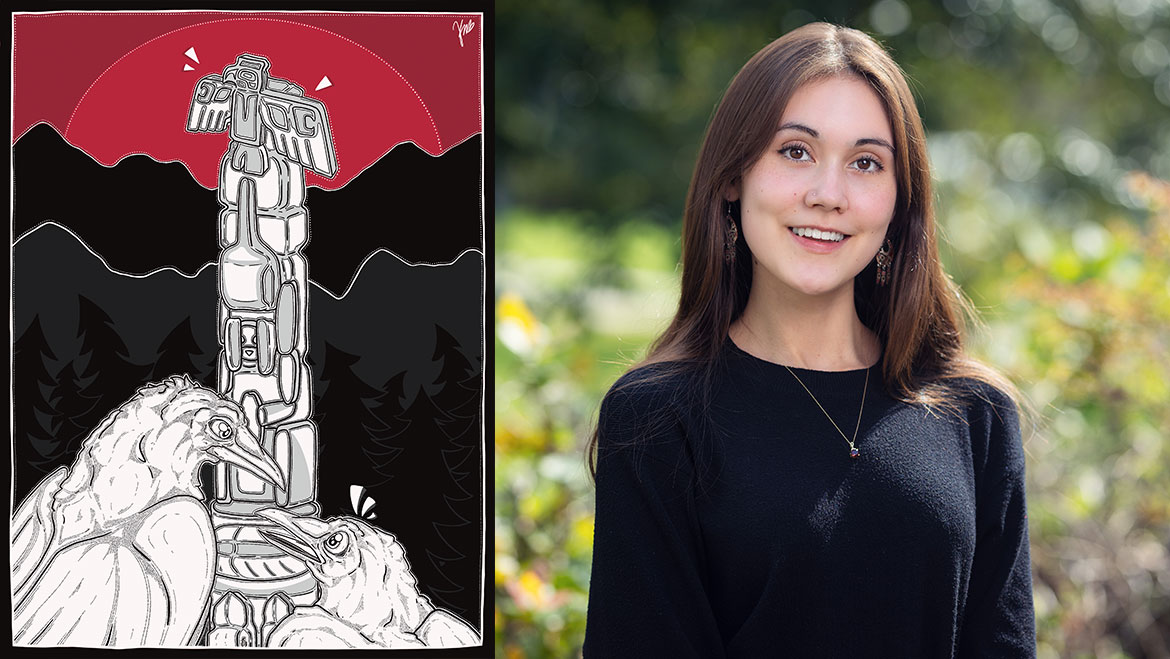

Photo by Martin Dee
Robyn is Red River Métis from her mother’s side and Ukrainian from her fathers side. She is a citizen of the Manitoba Métis Federation with Michif family names Bruneau, Nault, Curé and Harrison, some of whom took scrip in the Rat River Settlement and St. Boniface, Manitoba.
Her practice looks at relationships with the land and water through the intricate weaving of Indigenous knowledge, ceremony, art, and architecture. She seeks to create an architecture of poetic joy, alongside the matriarchs who have helped steward a sense of home for Indigenous communities through the dark times, to forge paths into brighter futures. Robyn is a fourth-year graduate student in the dual Master’s of Architecture and Landscape Architecture program in the Faculty of Applied Science.
We interviewed Robyn about the beadwork she created for the Indigenous Symbols and Signifiers initiative, which answers the question: What symbols represent belonging in your culture? Here’s what Robyn has to say.
About Robyn and her inspiration
Manitoba is my home, I grew up between Winnipeg and an hour north in Sandy Hook surrounded by prairie wildlife. As a kid, I spent a lot of time in the fields with my family. My dad is a water fowl hunter and we had a cottage in the interlake. My favourite thing to do would be swimming in the south basin on Lake Winnipeg or Birds Hill Park. This beadwork piece that I made is inspired by different native plants from those bodies of water and land. There are six different flowers and bead motifs, from wild rice to Wolf Willow; a really important plant for Indigenous communities. The seed in the berries is actually used in beadwork often to make jewelry and has historically been used in rosaries. Some people also call this plant a silverberry. Other parts of the plant have other medicinal and ceremonial purposes too.
This beadwork piece complements my thesis, where I created a 7-level Virtual Reality video game based on 6 different folklore characters from Little People to the Rougarou. The 7th level is a kitchen party where all the folklore characters (neighbours) come together for a shared meal around the ‘Kinship Table’.
The narrative of Kinship Table begins at the bottom, where you see the Wolf Willow plant in yellow. This plant also represents the Rougarou, and then just to the right of that, you have the wild rice which is connected to fresh water mermaids! The prairie crocus blooms with the snow and represents Paahkuk. The blueberries represent Thunderbird, and above that the prairie coneflower represents P’tit Jean, a trickster, and finally the purple asters represent the Little People. At the very top of the green mousetracks, a multicoloured flower combines all six different folklore neighbours and plants that represents a kitchen table with the whole neighbourhood. It was important for me to bring together this collection of mermaids and monsters while talking about architecture because in Métis community, we bring our whole selves to the table, the good and the bad.
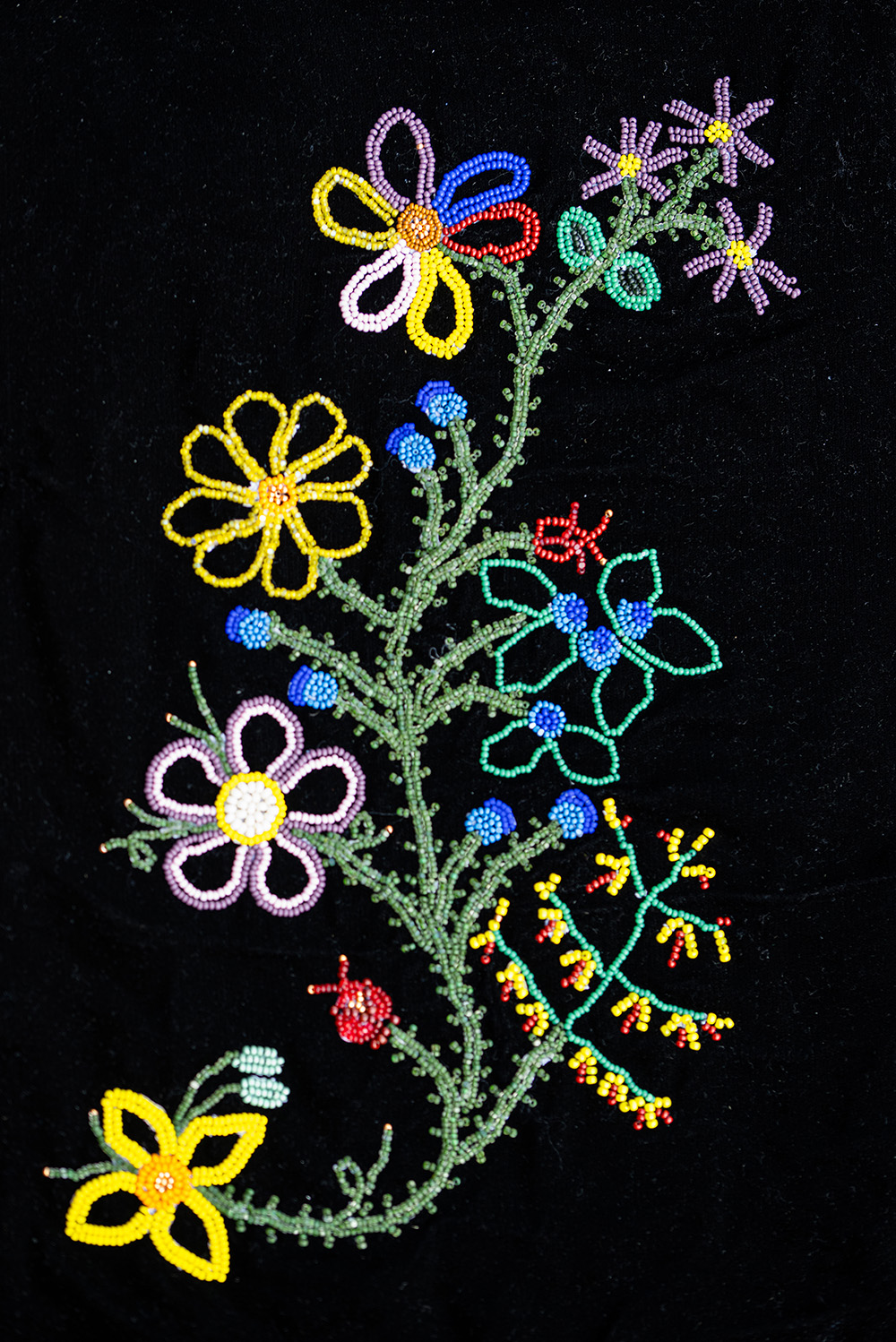
Kinship Table by Robyn Adams
Original artwork of Robyn titled "Kinship Table" which was inspired by Michif folklore and prairie flowers.

Beaded Asters digitized in Little People Level
Created by Robyn for her 2025 thesis

Kinship Table beadwork digitized in Kitchen Party level
Created by Robyn for her 2025 thesis
Getting architecture to meet beadwork
I first learned how to bead as a beginner eight or nine years ago from a few really amazing matriarchs. I first learned sitting across the work office kitchen table with Lor Brand, then through learning French with Mona Moquin and Nancy Gouliquer. During covid, I had the privilege to learn from Master beadwork artist Jennine Krauchi. Throughout the past 4 years of my time at UBC, I’ve been including beadwork into the process of many of my architecture assignments from beading floor plans, to beading a planting design. However, recently instead of adding beadwork into the typical architecture process, I am more interested in how architecture can fit into the beadwork process.
In Mètis academic scholarly research, and in grassroots community, the kitchen table is highlighted as the heart of a home. A lot happens at the kitchen table from parties, and gatherings to intergenerational knowledge sharing, eating meals together, to learning how to bead and sew. So to honour this practice, the kitchen table is the methodology behind my thesis project, focused on visiting and storytelling. This beadwork piece acts as a map, both to the geographic ecosystems and plant ID, but also to the relationships between the folklore characters in my video game.
“The kitchen table was actually the methodology behind my thesis project, with Michif folklore, architecture and traditional beadwork. I designed a video game where beadwork acts as a map for relationships and a fantasy world. At the end of the game, all the folklore characters come together and enjoy a meal around the kitchen table.”
There are so many teachings in beadwork, work made today and ancestral work. I often go to museum archives and find grandmother beadwork pieces. I love to learn from those works because they still hold a spiritual presence the beader wove into them and when researching the patterns, materials and archival history you can learn quite a bit about land-based processes. Some include the way materials were processed, like animal hides, natural dyeing of silk threads, or you can learn about plant identification and communities in relationship through patterns. How work is assembled also teaches about relationships of materials, knowledge, seasonality etc. Some patterns commonly known are mouse tracks, because of the mouse track pattern in snow – which is the green stem and tendril motif in my work which really highlights the connection between elements, and relationships of more than human ecologies between kin.
Learning about archival beadwork
Being able to access historical beadwork from museums, like the Museum of Anthropology, is really important for reclaiming practices that have been lost and stolen. More recently museums have been opening their collections to the Indigenous community, and work hidden away in vaults is getting shown, digitized and resurfaced through exhibitions. There are even really amazing repatriation initiatives happening led by communities that have found their cultural works in collections. Last year with one of the programs the MOA has, which allows Indigenous students to access their archives, I was able to see some Métis beadwork I have researched that was mislabeled and share what time frame and communities they were likely from.
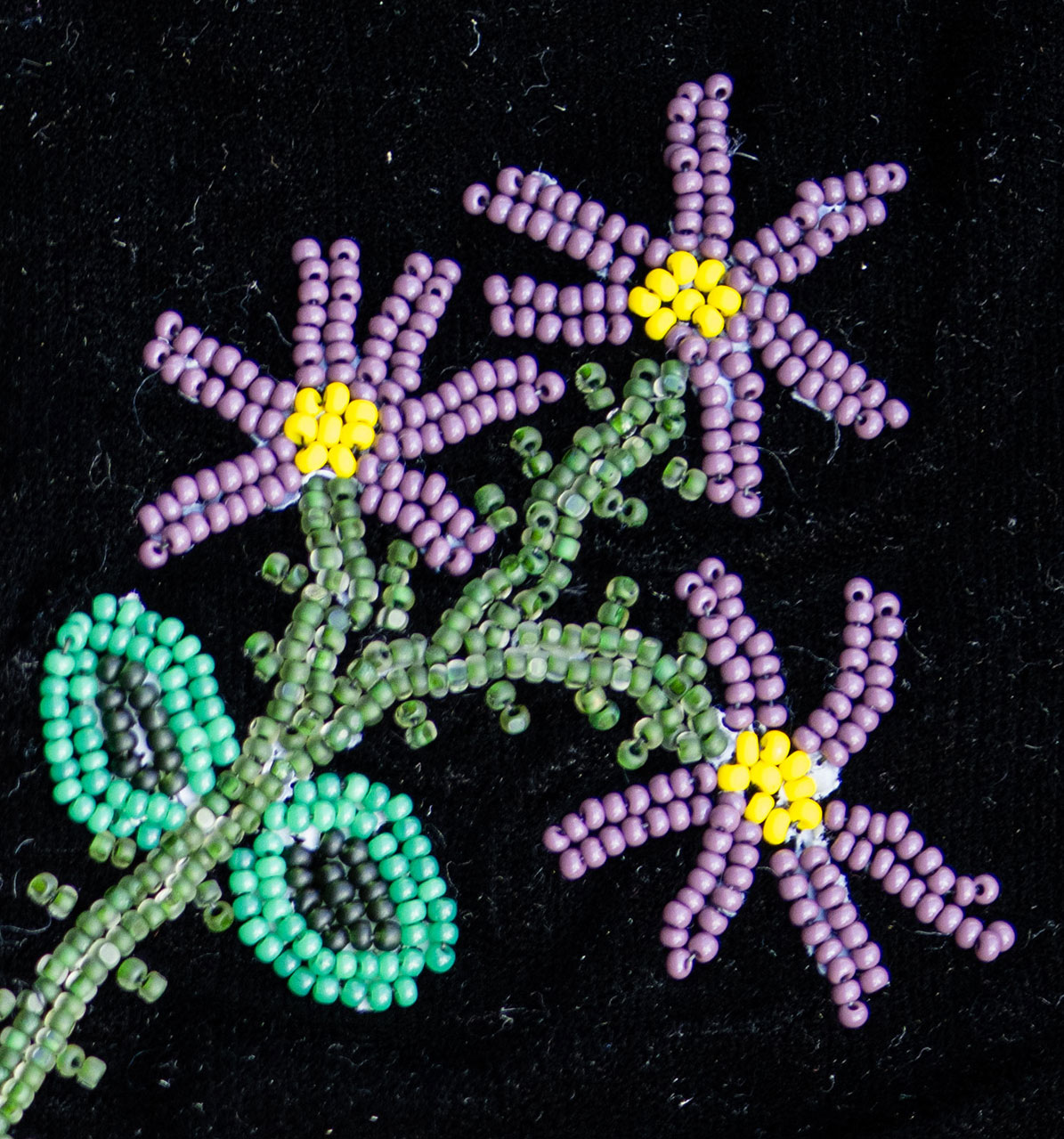
Asters beadwork
Asters, representing Little People in Michif folklore. Beadwork by Robyn Adams

Wild-Rice-Mermaids-Robyn-Adams-2025
Wild rice representing Mermaids from Michif folklore. Beadwork by Robyn Adams.

Wolf-Willow-Rougarou-Robyn-Adams-2025
Wolf Willow represents the Rougarou in Michif folklore. Beadwork by Robyn Adams.

Blue-Berries-Thunderbird-Robyn-Adams-2025
Blueberries representing the Thunderbird in Michif folklore. Beadwork by Robyn Adams
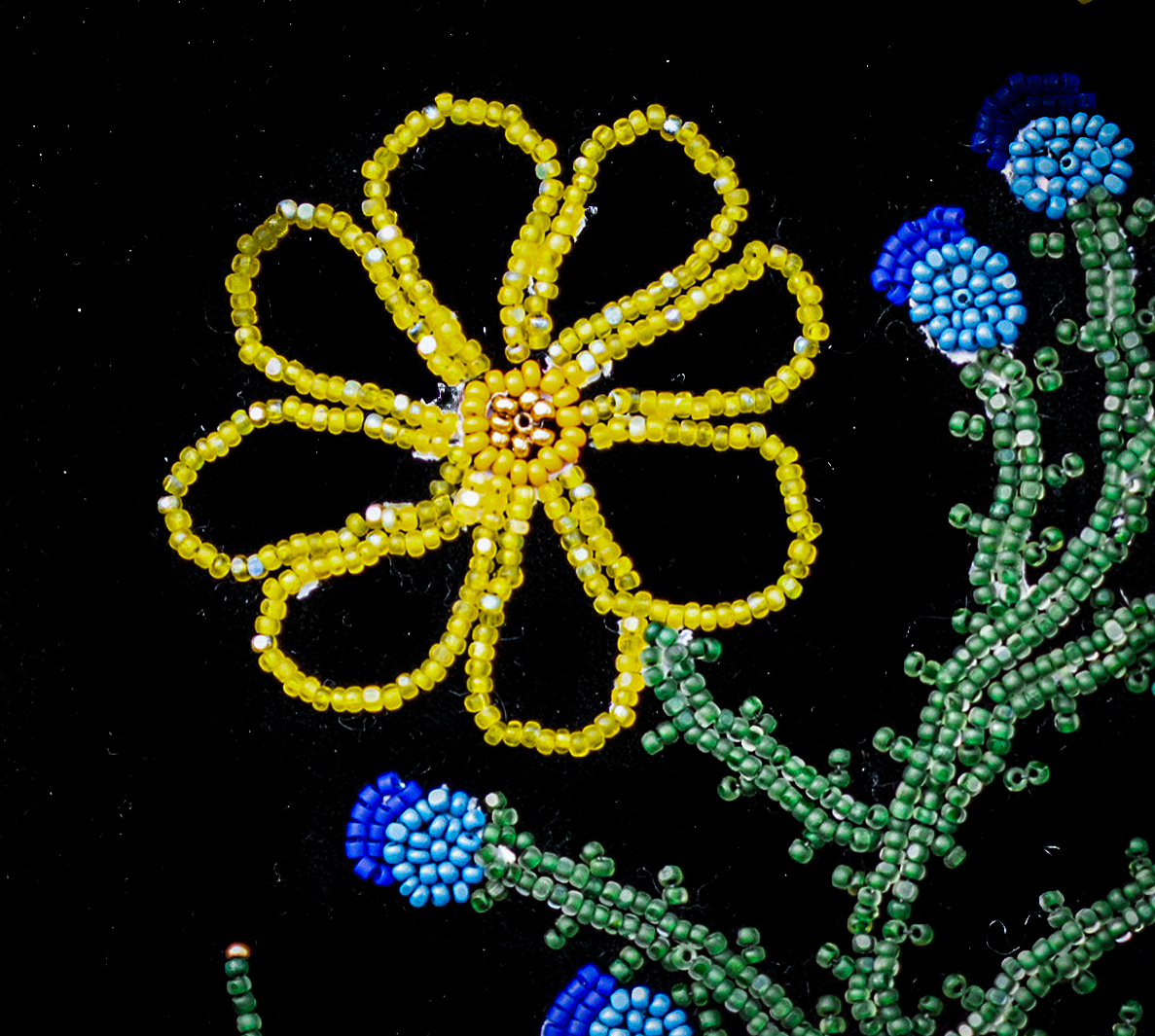
Prairie-Cone-Flower-Ptit-Jean-Robyn-Adams-2025
Prairie Cone Flower representing P'tit Jean from Michif folklore. Beadwork by Robyn Adams.
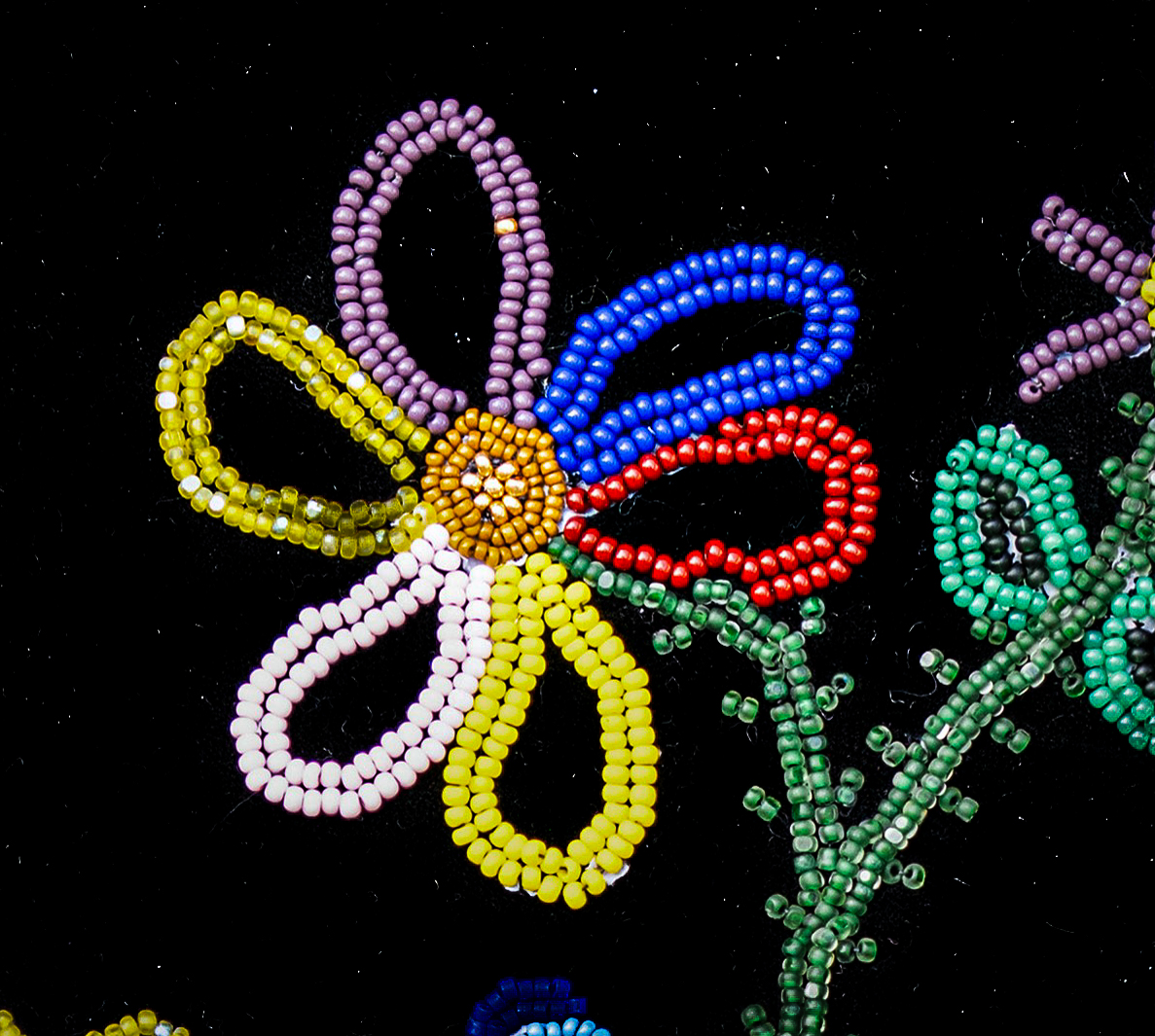
Kitchen-Table-Flower-Robyn-Adams-2025
Kitchen Table Flower. Beadwork by Robyn.

Prairie Crocus beadwork
Prairie Crocus representing the Paahkuk, from Michif folklore. Beadwork by Robyn.
Beadwork references relating to land-based knowledge
In this work, I wanted to highlight a couple different Métis beadwork motifs. Mouse tracks, in green with tendrils, gold tips on flowers which represent rain drops. To honour traditional beadwork, I also included the cycle of plants from buds to berries to flowers blooming. There’s also the spirit bead, a little gold bead in one of the flower patterns to remind me, while making this work, that only the creator is perfect. I like to think the spirit bead also connects me spiritually to this piece.
